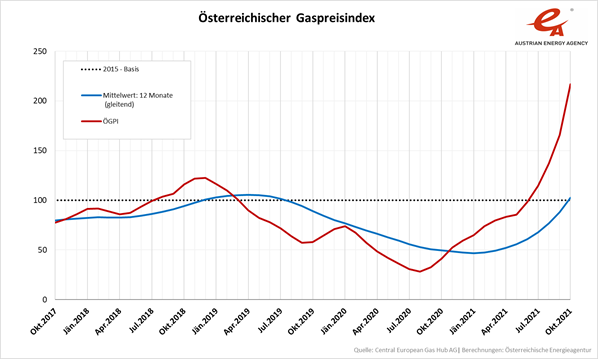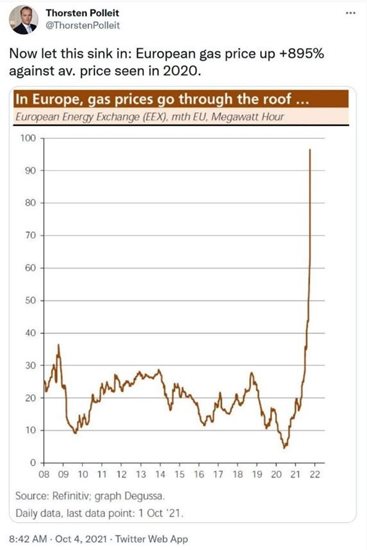Der extreme Anstieg der Gaspreise im Großhandel entwickelt sich zu einem gravierenden Kostenproblem für Hersteller energieintensiver Basischemie. Die Auswirkungen bei Stickstoffprodukten sind bereits deutlich zu sehen. Warum das so ist, welche Produkte besonders stark betroffen sind und wie es mit der Versorgung bestellt ist, lesen Sie in diesem Beitrag.
Weshalb der Gaspreis so stark gestiegen ist
In den vergangenen Monaten sind die Großhandelspreise für Gas weltweit auf Rekordstände gestiegen. Die Beschaffungspreise für Erdgas am Terminmarkt haben sich innerhalb eines Jahres um mehr als 400 Prozent erhöht. Waren im August 2020 noch durchschnittlich 4,80 Euro für eine Megawattstunde im Großhandel zu zahlen, so kostet diese am aktuellen Terminmarkt rund 44 Euro. Für eine kurzfristige Beschaffung gehen die Preise teilweise bis zu 75 Euro hinauf.
Experten gehen davon aus, dass das hohe Gaspreisniveau im Großhandel noch länger anhalten wird. Ein stärkerer Preisrückgang wird erst im Frühling 2022 erwartet. Die Ursachen für diese Kapriolen am Energiemarkt sind sowohl im Angebot als auch in der Nachfrage begründet:
- Weltweit steigende Nachfrage: Die hohe Nachfrage im Zuge der Erholung der Weltwirtschaft trifft derzeit auf ein vermindertes Angebot. Ein hoher Anteil an Flüssiggas (LNG) wird zudem in den asiatischen Markt und nach Nord- und Südamerika geliefert, weniger jedoch nach Europa im Vergleich zu den letzten Jahren. Grund hierfür sind die verringerte Energieproduktion der Wasserkraftwerke in genannten Ländern infolge der Hitzewelle sowie bessere Preise für Gaslieferanten als in Europa.
- Hoher Gasverbrauch: Kalte Winter in vielen Regionen sowie eine über mehrere Monate unterdurchschnittliche Windkraft-Einspeisung ließ die Gaslagerbestände in Europa sinken. Als Folge müssen konventionelle Kraftwerke mehr Strom produzierten – und dies ebenfalls teilweise mit Gas.
- Relativ niedrige Lagerbestände: Normalerweise werden die Gasspeicher im Sommer zu günstigen Preisen wieder aufgefüllt. In diesem Jahr ist dies aus verschiedenen Gründen nicht geschehen. Wegen der hohen Gaspreise sind nun die Gasspeicher in der EU durchschnittlich nur zu 70 Prozent aufgefüllt. Die Füllstände der für Österreich relevanten Speicher liegen laut E-Control derzeit zwischen 66 und 87 Prozent, also in einem einigermaßen normalen Ausmaß.
- Verringerte Gasproduktion in Europa: Die sukzessive Abschaltung des Groningenfeldes in den Niederladen sowie das sinkende Angebot aus Großbritannien führt zu einer substantiell verringerten Menge an Erdgas in Europa. Hinzu kommen diverse Wartungsarbeiten bei europäischen Gasförderländern wie Norwegen.
- EU-Energiepolitik: Die ausstehende Betriebsgenehmigung für die fertiggestellte Ostseepipeline NordStream 2 könnte einen zusätzlichen Effekt auf die Preise haben. Grundsätzlich geht es in dem Streit zwischen der EU und Russland darum, ob die 2019 geänderte europäische Erdgasrichtlinie angewandt wird oder nicht. Die Richtlinie sieht vor, dass Gaspipelines zwischen der EU und Drittstaaten den Vorgaben der europäischen Regulierung entsprechen müssen.

Der Österreichische Gaspreisindex (ÖGPI) steigt im Oktober 2021 im Vergleich zum Vormonat September um 30,9 %. Gegenüber Oktober 2020 liegt er um 425,1 % höher. Der von der Österreichischen Energieagentur berechnete Index steigt im Oktober 2021 auf 217,01 Punkte. In den vergangen zwölf Monaten lag der ÖGPI im Schnitt bei 102,64 Punkten.
© Austrian Energy Agency
Gaspreis führt zu Preisanstieg im gesamten Energiesektor
Die Preisexplosion bei Gas zieht weite Kreise und beeinflusst direkt und indirekt den gesamten Energiesektor. Hohe Preissteigerungen sind vor allem bei Strom, aber auch Kohle und Erdöl zu verzeichnen:
- Strom: In Europa wird Strom nach wie vor sehr stark durch Gas erzeugt. Die Gaspreissteigerung auf den Großhandelsmärkten wirkt sich somit 1:1 auf den Strompreis aus. Während zu Beginn des vierten Quartals 2020 der Strompreis bei 40 Euro pro Megawattstunde lag, beträgt der Preis ein Jahr später mit mehr als 120 Euro das Dreifache.
- Erdöl: Da die Preise für Gas und Kohle in den vergangenen Monaten stark angestiegen sind, kommt Öl als alternative Energiequelle zunehmend in Betracht. Das treibt die Erdölpreise ebenfalls stark an. Derzeit kostet ein Barrel der Nordseesorte Brent so viel wie vor rund drei Jahren. Der US-Ölpreis notiert sogar auf dem höchsten Niveau seit sieben Jahren.
- Kohle: Höhere Gaspreise erhöhen die Nachfrage nach Kohle, beispielsweise in der Stromerzeugung.

Die extremen Preissteigerungen im Erdgasgroßhandel bewirken mit Verzögerung nun auch beim Strompreis deutliche Erhöhungen.
© Austrian Energy Agency
Gravierendes Kostenproblem für energieintensive Unternehmen
Generell sind derzeit bei einer Vielzahl von Chemikalien starke Preisanstiege durch gestiegene Energiekosten zu verzeichnen. Grundsätzlich kann man hier zwei Gruppen unterscheiden:
- Der ersten Gruppe sind Chemikalien zuzurechnen, die durch die Koppelung von Gas- und Strompreis indirekt von steigenden Energiekosten betroffen ist. Dazu sind etwa Elektrolyseprodukte wie Natriumlauge und Kalilauge zu zählen, deren Erzeugung sehr stromintensiv ist.
- Die zweite Gruppe ist im Herstellungsprozess direkt von Erdgas abhängig.Die Produktion von Stickstoffprodukten ist derzeit von Auswirkungen der Gaspreisexplosion besonders stark betroffen.
Elektrolyseprodukte verzeichneten innerhalb des letzten Quartals Preisanstiege zwischen 20 bis 25 Prozent. Für diese Produktgruppe ist das durchaus dramatisch. Kritischer sind derzeit allerdings die Preisanstiege von Stickstoffprodukten zu bewerten.

Produktionsanlage zur Herstellung von Ammoniak und Stickstoffdüngern. © Всеволод Чуванов, stock.adobe.com
Stickstoffprodukte von Gas abhängig
Der Preis für Stickstoffprodukte hängt in erster Linie von den Energiekosten für den Betrieb der Produktionsanlagen ab. Erdgas spielt hier eine zentrale Rolle. Der Rohstoff selbst, nämlich Luft, fällt kostentechnisch nicht ins Gewicht.
Die technisch wichtigste Stickstoffverbindung ist Ammoniak. Die Chemikalie wird direkt aus der Luft hergestellt und dient als Grundstoff für alle anderen stickstoffhaltigen Verbindungen:
- Die Ausgangsstoffe für die Ammoniaksynthese erhält man aus der katalytischen Umsetzung von Erdgas (Methan) mit Wasserdampf und Luft.
- Bei diesem Prozess entsteht ein Gasgemisch aus Wasserstoff und Stickstoff, welches nach dem Haber-Bosch-Verfahren zu Ammoniak weiterverarbeitet wird.
Der hohe Energiebedarf bei der Herstellung des benötigten reinen Wasserstoffs im Haber-Bosch-Verfahren ist letztlich auch der Grund für den enormen Preisanstieg bei Stickstoffprodukten: Steigen die Kosten für Erdgas, dann steigen in gleichem Maße die Preise für Ammoniak und daraus erzeugter Stickstoffprodukte.

Düngemittelindustrie massiv unter Druck
Die Hauptanwendung von Ammoniak umfasst zu 80 Prozent die Herstellung von landwirtschaftlichen
Düngemitteln. Ammoniak kann alleine als Dünger ausgebracht werden, wird jedoch meist in andere Stickstoffprodukte wie Harnstoff oder Nitrate umgewandelt. Die restlichen 20 Prozent werden unter anderem zur Produktion verschiedener organischer Zwischenprodukte sowie Kunststoffe und Synthesefasern eingesetzt.
Das inzwischen erreichte Niveau der Erdgaspreise macht es für Düngemittelproduzenten schwieriger, kostendeckend zu produzieren. Der österreichische Düngemittelhersteller
Borealis AG hat bereits die Notbremse gezogen und seine Ammoniak-Produktion in Europa heruntergefahren. Auch einige andere große Produzenten drosseln inzwischen die Düngerproduktion.

Ammoniak ist eine der wichtigsten Basischemikalien und dient als Ausgangstoff für zahlreiche chemische Synthesen. © Donauchem
Preise hoch, Versorgungslage derzeit stabil
Alleine im Oktober stiegen als Folge der Gaskrise die Preise für Stickstoffprodukte innerhalb von zehn Tagen um bis zu 170 Prozent.
Eine unmittelbare Bedrohung der Mengenlieferungen bei Stickstoffprodukten besteht nach Einschätzung der Donauchem Lieferanten derzeit jedoch nicht. Auch liegen keine Informationen vor, dass es wegen der Energiepreise in der gesamten Branche zu Abschaltungen von Produktionsanlagen kommen wird.

Preisrange bei Stickstoffprodukten im Großhandel (je nach Hersteller) © Donauchem
Fazit: Was die Donauchem für Ihre Versorgungssicherheit unternimmt
Die Donauchem beobachtet die aktuellen Entwicklungen sehr genau und greift im Rahmen machbarer Optionen unterstützend und ordnend ein. In Kooperation mit Kunden und Lieferanten fokussieren wir vor allem darauf, das Preisgefüge soweit als möglich zu stabilisieren. Die Versorgungssicherheit für Stickstoffprodukte ist zum aktuellen Zeitpunkt gegeben, wenn auch mit erheblichen Preisaufschlägen. Unseren Qualitätsansprüchen bleiben wir selbstverständlich trotz angespannter Preissituation treu – in unserem Portfolio werden Sie auch weiterhin nur hochwertige Produkte finden.
 www.donauchem.at
Weiterführende Links:
News to go - Gaspreis auf Rekordniveau
Tagesschau.de
www.donauchem.at
Weiterführende Links:
News to go - Gaspreis auf Rekordniveau
Tagesschau.de - Wie der hohe Gaspreis entsteht
Tagesschau.de - Teurer Dünger belastet Landwirte
Focus.de - Dünger so teuer wie seit 13 Jahren nicht mehr
orf.at - Wie mann Stickstoffdünger einsparen könnte